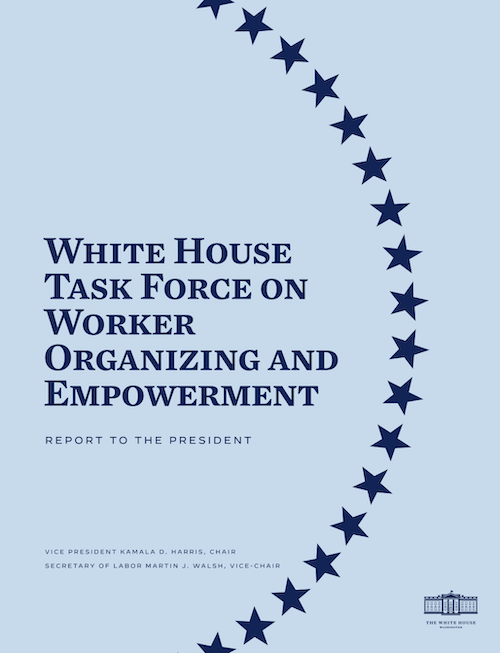The first-of-its-kind task force that President Joe Biden created last year to identify ways that his administration can help empower workers and strengthen unions has returned with nearly 70 recommendations for federal agencies to pursue.

|
| The Cabinet-level task force spent six months doing research and interviews before compiling its 46-page report with nearly 70 recommendations to reduce the nation’s long decline in union membership and restore workers’ voices on the job.
|
"Their 43-page report is a roadmap for bolstering workers’ rights and bettering their lives through policies that support union organizing and collective bargaining, goals Biden has championed from the White House bully pulpit like no president before him.
“This is a significant milestone,” International President Lonnie R. Stephenson said. “By recognizing and uplifting the critical role that labor unions play in improving the lives of working people, the Biden-Harris administration is once again leading by example and delivering victories for working people.”
The catch, as emphasized by labor leaders and the task force itself, is that executive branch policy can only do so much for workers for so long. Lasting protections demand legislation.
“To truly secure the rights of workers to freely and fairly form and join unions, Congress must pass Protecting the Right to Organize Act,” Stephenson said.
Officially the White House Task Force on Worker Organizing and Empowerment, the panel is chaired by Vice President Kamala Harris and Labor Secretary Marty Walsh and comprises 24 Cabinet secretaries, agency heads, and top advisors.
Their report was developed over six months of research and interviews with experts and stakeholders, including unions. Members of the IBEW played a leading role last summer when Pittsburgh Local 5 hosted a roundtable where Harris and Walsh met with organizers from eight unions.
“The number and breadth of ideas presented to the task force is both inspiring and unprecedented,” the report states. “The range of policies, practices and programs that can be leveraged is significant.”
Making the federal government a model union-friendly employer tops the panel’s long list and begins with ensuring that the current workforce and new applicants know their rights and how to exercise them.
It is a considerable hill to climb given that only 20% of the 1.2 million non-postal federal workers are union members. Among them, some 300,000 workers are eligible but have no bargaining unit and more than 835,000 benefit from representation but don’t pay dues.
Government Employees Director Paul O’Connor cautions that marked progress will likely demand more direct language than what the Office of Personnel Management has put out so far.
"I see words like 'urging agencies' and 'strongly encourage agencies.' Nothing in the OPM guidance requires agencies to do anything,” he said, stressing that the IBEW has long modeled the kind of outreach recommended in the report.
"The IBEW does a much better job than most other unions when it comes to organizing new employees in federal sector open shops,” O’Connor said. “Federal employees need to know their rights. They need to know how and where to access information. And it is always helpful when a president's administration understands the value of labor unions and takes steps to educate employees on those values."
From widespread policies lifting up both public and private sector workers to such agency-specific items as making sure Bureau of Ocean Energy Management wind leasing projects are built with union labor, the list goes on.
It includes expanded online organizing tools, promoting apprenticeships, seating more union members on federal advisory panels, visibly stronger enforcement of and penalties for employers who break labor laws, and more documentation of employers’ anti-union campaigns.
Greater transparency and collaboration among agencies are recurring themes. Proposals for financial strategies to help workers exercise their rights and deter employer abuses are another key component.
Among them, the panel recommends asking the Treasury Department to explore tax policies that would restore workers’ union-dues deduction and deny employers a write-off for money spent “to impede or inhibit” organizing drives. Also, it urges the government to leverage its purchasing and spending power to promote pro-worker values, from tying federal contracts and grants labor standards to closing loopholes in Made-in-America laws.
The panel is expected to issue a progress report later this year, with the caveat that the “recommendations do not and cannot take the place of the robust legislative change that is needed to fix our labor laws.”
Several important bills are pending but none is more far-reaching than the landmark PRO Act, which would put teeth back into the badly eroded 1935 National Labor Relations Act. Organizing rights, good-faith collective bargaining, recourse for fired workers, consequences for union-busting employers, and more would become a matter of law rather than policy.
Political and judicial assaults on labor rights began before the ink was dry on the NLRA and are at least as ferocious now, as billionaires bankroll union-busters and help elect anti-worker candidates to Congress and statehouses.
The report juxtaposes the relentless attacks with current polls showing that two-thirds of Americans favor unions — the highest approval since the mid-1960s. And more than half of non-represented workers say they’d join a union immediately given the chance, as reflected by the today’s flurry of organizing drives at behemoth employers and in non-traditional industries.
“We face a unique moment when factors have converged to create real opportunities for worker organizing,” the report states. “To take advantage of these opportunities, this increased interest in unions must be met by corresponding and responsive changes in government policy and practices, such as those contemplated by the recommendations in this report.”
“However, our work serves as a reminder that existing law is heavily tilted against the rights and needs of working people. We need new laws today, just as we did in the 1930s.”